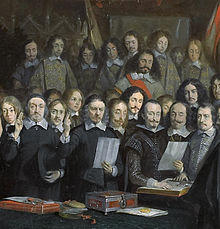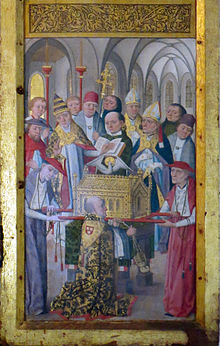Oath Chapel of the Lübeck Council

The Oath Chapel of the Lübeck Council was a late Gothic oath in the Lübeck town hall that was in use until 1811. It was made of gilded silver and was designed in the shape of a church, similar to a reliquary .
The oath chapel kept in the town hall treasury was presented on special occasions as well as on court days. Among other things, it served the newly elected councilors to confirm and illustrate their oath.
During the Lübeck French period , the valuable gem of the Lübeck Council had to be delivered to the Governor General of the Département des Bouches de l'Elbe in Hamburg Louis-Nicolas Davout and has been missing since then.
Manufacturing and environment

Medieval (pre-Reformation) oath chapels as metalwork have also been handed down in other cities in northern Germany, without a conclusive scientific study of the use and distribution of this form of the oath box being available to this day. The oath chapel of the city of Tangermünde , which was made in 1461 by the goldsmith Valentin Pust, is well known. While the Eideskapelle in Tangermünde can be dated, the Lübeck Eideskapelle can only be assigned to the late Gothic period from around 1350. An indication of their (non-) existence can be found in the Lübeck chronicles , according to which, after the Lübeck council was driven out in the course of the civil unrest in 1408, the new councilors took their oath "dat gulden creute, dat de herren hebben up dem hus" , that is, a golden oath cross . Lambacher dates the Lübeck Eideskapelle with reference to the Eideskapelle from 1461 in Tangermünde and the Hamburg Eideskapelle, shown twice by Absolon Stumme in 1497 , also made in 1461 by the goldsmith Johann Schröder, vaguely to the last quarter of the 15th century and suspects a Lübeck master goldsmith than the manufacturer. The Lüneburg to Council silver belonging oath of citizenship Crystal dated inscriptions to the year 1443 and by the goldsmith Hans Laffert signed.
The sacred architectural form of the Lübeck Eideskapelle can be understood as a pre-Reformation sacralization of Lübeck's city history or the Lübeck Council and its self-confident claim to power in the city regime of the Free Imperial City . Annette Reitz-Diense, a theologian, sees a similar development in the council archives , which were set up in the Tresekammer of Lübeck's Marienkirche from 1298 . The Marienkirche was built as a (pre-Reformation) council church in declared competition with the bishop's church, the Lübeck cathedral .
Use and function
The shape of the oath chapel indicates the role of the church as guarantor of the oath. The election of the council itself was preceded by intercessions in church services (of the city churches) in Lübeck. The newly elected councilors met again before the oath in Lübeck's Marienkirche . The oath itself took place in the council chamber, where the council's jewel was placed. The new councilors knelt there in pairs and swore the oath with one finger on the oath chapel.
The Lübeck oath chapel was in Luebeck city hall in the combing custody and stood at the St. Peterstag , each of the new council (Senate) was put on the, before the newly elected councilors. This made the connection to the council oath clear, which the councilors newly elected by the council on the principle of self- completion had to take to the council itself, not to the city or its citizens. But it was also used for court hearings by the Oberhof and lower courts until, in the first third of the 16th century, the court lords in the council received another, wooden oath chapel, which was modeled on the older model.
loss
The Eideskapelle was part of the Lübeck Council Silver for over 400 years . It lost its symbolic function during the French era, when the Lübeck council was dissolved and replaced by the municipal council of a brief bonne ville de l'Empire français . While all of the rest of the council silver was used to reduce the city's debt - with moderate to extremely low proceeds as a result of the collapse in demand due to the demand for silver - the oath chapel, whether because of its symbolism or personal desirability, was at the express order of the governor general of the département des Bouches de l 'Deliver Elbe Louis-Nicolas Davouts in Hamburg. The so-called Lübeck Silver Treasure , on the other hand, is a private collection of exhibits of old Lübeck goldsmithing, which was only brought together in the period after the Second World War and bought by the Lübeck museums in order to close a gap that had arisen.
description
The oath chapel was described and drawn by Syndicus Carl Henrich Dreyer . It had a rectangular floor plan, a gable roof and a turret on every corner. According to the descriptions, it was silver-gilded, about a foot high and long with a width of 1/2 foot and weighed the equivalent of 848 grams (= 58 solder of silver). They were decorated with reliefs and inscriptions:
- The gable roof showed the majestas domini in the mandorla between a bishop and another saint, surrounded by the Twelve Apostles below . The Latin inscription on the gable roof read: “EGO. SVM. LUX. MVNDI. QVI. SEQVITVR. ME. NON. AMBVLAT. IN. TENEBRIS "; German: “I am the light of the world. Whoever follows me will not walk in the darkness. ”( John 8:12 ESV )
- On the other roof surface the crucified Christ was depicted between Mary and John, with the Latin inscription "JESVS NAZARENVS REX JVDEORVM".
- The roof ridge bore the inscription "OS QVOD INIQVA IVRAVERIT OCCIDIT ANIMAM DOMINI", German: "A mouth that swears falsely kills the soul of the Lord."
The latter inscription on the palm rest ( top view ) of the oath chapel thus referred directly to the oath to be taken.
Oath Chapel of the Lübeck Lower Court
The oath chapel of the Lübeck lower court is an oath chapel made of oak based on the model of the silver-gilded oath chapel of the council, which is dated to the first third of the 16th century. It shows the twelve apostles on the long sides and the Lübeck double coat of arms on the narrow sides, which are shaped into stepped gables. The original octagonal ridge turret has been lost and was later replaced by a gallows frame with bells. This oath chapel was 1612 new color taken and on the base of the ridge turret with the arms of the two this year reigning court masters of Lübeck Council, the councilors Johann Lüneburg and Lorenz Möller provided. It is now in the St. Anne's Museum .
Wooden post-Reformation sworn shops in sacred architectural form are known from Zwickau , Rendsburg , Werben , Kiel , Bremen and two copies in Lüneburg .
Comparable reliquaries in Lübeck art
A reliquary (chapel with pinnacles on the corners), which is very similar in design to the oath chapel of the council, can be found at the bottom right of the Sunday page in the Lukas altarpiece of the Lübeck painter's office, which was painted by Hermen Rode around 1490 . It was originally in the Katharinenkirche in Lübeck and is now one of the central collection items on the altars of the Museum of Art and Cultural History in the St. Anne's Museum.
literature
- Friedrich Bruns , Hugo Rahtgens , Lutz Wilde : The architectural and art monuments of the Hanseatic city of Lübeck. Volume I, Part 2: City Hall and public buildings of the city. Max Schmidt-Römhild, Lübeck 1974, ISBN 3-7950-0034-3 , pp. 269/270.
- Friedrich Bruns: The Lübeck Council. Composition, addition and management from the beginning to the 19th century. In: Journal of the Association for Lübeck History and Archeology . 32 (1951), pp. 1-69.
- Antjekathrin Graßmann : Lübeckische Geschichte. 2nd Edition. Lübeck 1989.
- Dietrich Poeck: Rituals of the council election: Signs and ceremonial of the council in Europe (12th-18th centuries). (= Urban research / A: representations. 60). Böhlau, Köln / Weimar 2003, ISBN 3-412-18802-6 , esp.p. 180.
- Lothar Lambacher: Goldsmith's art in Lübeck around 1500. In: Jan Friedrich Richter (Hrsg.): Lübeck 1500 - art metropolis in the Baltic region. Catalog. Imhoff, Petersberg 2015, pp. 104–112.
Web links
Individual evidence
- ↑ Life dates and other works unknown, see Wolfgang Scheffler : Goldschmiede Mittel- und Nordostdeutschlands: From Wernigerode to Lauenburg in Pomerania. Dates - works - signs. Walter de Gruyter, 1980, p. 537.
- ^ Peter Knüvener, Dirk Schumann: The Mark Brandenburg under the early Hohenzollern: Contributions to history, art and architecture in the 15th century. Lukas Verlag, 2015, p. 405 ff.
- ↑ Friedrich Bruns , Hugo Rahtgens , Lutz Wilde : The architectural and art monuments of the Hanseatic city of Lübeck . Volume I, Part 2: City Hall and public buildings of the city . Max Schmidt-Römhild, Lübeck 1974, p. 269.
- ^ Lothar Lambacher: Goldsmith's art in Lübeck around 1500. P. 106.
- ↑ a b Annegret Reitz-Dinse: Communication with God: Mediality and sacredness of church buildings and their use using the example of St. Mary's Church in Lübeck. Neukirchener Theologie, Neukirchen-Vluyn 2012, p. 62 ff. (On the Eideskapelle, p. 65 ff.)
- ↑ Dietrich Poeck: Rituals of the council election: Signs and ceremonial of the council in Europe (12th-18th centuries). (= Urban research / A: representations. 60). Böhlau, Köln / Weimar 2003, ISBN 3-412-18802-6 , pp. 178-180.
- ↑ Eberhard Isenmann: The German City in the Middle Ages, 1150–1550: city structure, law, constitution, city regiment, church, society, economy. Böhlau Verlag, Cologne / Weimar 2014, p. 367 ff. (Generally on the oath of advice)
- ^ Antjekathrin Graßmann : Lübeckische Geschichte. 2nd Edition. Lübeck 1989, p. 545; according to Lothar Lambacher (2015), the order for delivery was given by the prefect of the department Patrice de Coninck (1770-1827).
- ↑ Carl Henrich Dreyer: Introduction to the knowledge of the spiritual, civil, court, action, policey and chamber matters by E. Hochw. Council of the Imperial City of Lübeck from time to time issued general ordinances, mandates, standards, decrees, as well as the relevant legal documents. Donatius, Lübeck 1769, p. 359.
- ↑ Inscriptions and translation from BuK, Volume I, Part 2, pp. 269/270 with reference there to Dreyer's tradition; it must be called inique ; See also Wisdom 1,11 EU os autem quod mentitur occidit animam , a mouth that lies, kills the soul .
- ↑ Friedrich Bruns , Hugo Rahtgens , Lutz Wilde : The architectural and art monuments of the Hanseatic city of Lübeck. Volume I, Part 2: City Hall and public buildings of the city. Max Schmidt-Römhild, Lübeck 1974, p. 203.
- ↑ Figure in the picture index of art and architecture ; Illustration in the Library of the University of Pennsylvania
- ^ Peter Knüvener, Dirk Schumann: The Mark Brandenburg under the early Hohenzollern: Contributions to history, art and architecture in the 15th century. Lukas Verlag, 2015, p. 405. with further references
- ↑ Description of the retable by Uwe Albrecht (ed.): Corpus of medieval wood sculpture and panel painting in Schleswig-Holstein , Volume I: Hanseatic City of Lübeck, St. Annen Museum . Kiel: Ludwig, 2005. ISBN 3933598753 , pp. 248-257.



